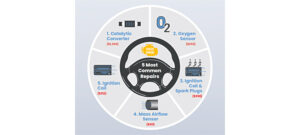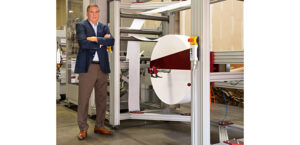During the first half of 2021, wafer fab capacity constraints were getting the most attention, but now other related constraints are concerns
London—IHS Markit analysts Mark Fulthorpe and Phil Amsrud offer the latest analysis on the global semiconductor shortage, automotive supply chain challenges and global light vehicle production impacts, including the latest IHS Markit forecasts, reflecting light vehicle production impacts well into 2022.
Wafer and Semiconductor Capacity Remains Tight
For the first half of 2021, the semiconductor shortage issue was mainly that of wafer, front-end capacity. The good news is the disruptions due to the fire at Renesas’s Naka facility and the ice storm in Texas that impacted NXP, Infineon and Samsung fabs are largely behind us. Wafer fab capacity remains tight, but with those plant disruptions behind us, the impact is lower than in the first half. Having wafers is necessary to make integrated circuits (ICs) but not sufficient. The front-end process is followed by the back-end assembly and test process, which is another challenge.
While front-end processing transforms a raw 200mm or 300mm silicon wafer into thousands of dice, each die needs to be packaged to provide a complete IC that can be soldered onto a circuit board to be part of an electronics control unit (ECU).
“Wafer fab capacity got all the attention early this year, and rightly so, but if you can’t put the die into a package so it can be put into an ECU, then you still can’t produce and sell a car.”
— Phil Amsrud, senior principal analyst, IHS Markit
Once the wafers are processed they are sent to the assembly and test location to be diced, packaged and tested before sending them to a customer to be placed into an ECU and then into a car.
Constraints in the back-end process can disrupt the supply chain just like the constraints in the front-end process. During the first half of 2021, wafer fab capacity constraints were causing the greatest disruption and getting the most attention, but now that those have improved, other related constraints in getting leadframes, substrates and resins are getting attention.
COVID-19 Still Impacting Supply Chain
Unlike the capacity constraints in wafer fabs, which was impacting mainly automotive MCUs, assembly capacity constraints impact all semiconductor types including sensors, power supplies and discretes. Assembly and test locations are concentrated in China, South Korea, Japan, Singapore, Philippines, Indonesia, Thailand, Vietnam and Malaysia. With the exception of Singapore and Malaysia, the vaccination rates are reported to be less than 6 percent for many of these countries, according to the Center from Strategic and International Studies.
Malaysia has been shutdown due to COVID-19 outbreaks recently and its vaccination rate is almost 12 percent. Several of these countries have seen their average infections increase over the past two weeks, and the ongoing threat of COVID-19 impacting labor forces in other countries is real. This threatens the operators at the assembly and test locations themselves as well as the workers necessary to move the finished products to distribution hubs for global distribution.
Like wafer fab capacity, there is a need for expanded packaging capacity. However, the margins in assembly and test are a fraction of those in wafer fabs, so there is more hesitation to add capacity speculatively. There also is a shortage of assembly equipment, with some lead times increasing to 40 weeks. One of the main reasons the lead times for this equipment has increased is because they cannot get semiconductors. In short, the equipment needed to make more semiconductors has limited availability because they cannot get enough semiconductors.
As result, IHS Markit expects the semiconductor shortages across the automotive sector now extending into Q1 2022 and possibly into Q2. Both Intel and Infineon have cautioned that the situation may persist throughout all of 2022. So while improvements in wafer capacity has improved, the situation is still fraught with challenges.
Global Light Vehicle Production Forecast Implications — Latest Update Reflects 8.3 percent Increase over 2020
The global forecast for light vehicle production in 2021 now stands at 80.78 million units with our latest August release. This represents an 8.3-percent increase over 2020 levels.
“Output lost to disruption to the semiconductor supply chain is estimated to have reached 1.44 million units in Q1 and 2.60 million units in Q2. Visible downtime in Q3 now stands at 1.60 million units underlining the assessment that Q3 will continue to see disruption, and this is becoming more significant. While we do not expect to see levels of disruption like those in Q2, it now seems highly likely that the impact will be in the range of 1.8 to 2.1 million units for the quarter if the rate of downtime that we currently see was to continue through September. We expect Q4 will be exposed to ongoing disruption and this disruption is now expected to spill over into Q1 2022. Q2 2022 may be the point at which we look for the stabilization of supply, with recovery efforts now starting only from H2 2022.
Across the full year, taking the estimates for Q3 and Q4, in addition to the losses already identified in the first half of the year, this would put the full-year risk associated with semiconductor shortages between 6.3 million to 7.1 million units globally, according to IHS Markit estimates.”
— Mark Fulthorpe, executive director, global light vehicle forecasting, IHS Markit
The situation in Q3 is undermined by some delay at Renesas. Though manufacturing capacity has been restored, the ability to fulfill shipments may not be possible until September. We are also seeing additional volatility due to COVID-19 lockdown measures in Malaysia where many back-end chip packaging and testing operations are performed. As this is more labor-intensive than the wafer fabrication processes, activity is more easily affected by public health measures that impact workforce participation.
In view of these developments, we expect Q4 will be exposed to ongoing disruption and this disruption is now expected to spill over into Q1 2022. Q2 2022 may be the point at which we look for the stabilization of supply, with recovery efforts now starting only from H2 2022.







Comments are closed.